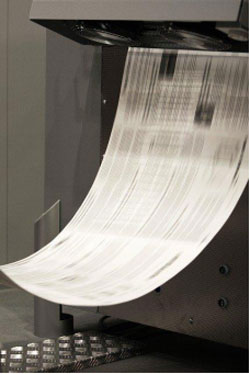Almost all companies will get to the point where they need to print information on paper for clients, customers, or other people to read. Printing companies are capable of printing quality collateral for other businesses in high quantities, making them more ideal in most situations than printing collateral with one’s own printer.
For printing commercially, there are two types of paper to choose from, both of which printing companies can use within chosen design patterns. These are uncoated paper and coated paper.
The Difference Between Both Paper Stock Types
All paper originates as an uncoated paper stock ( like the paper you use in your desktop printer, e.g. 20lb. bond or 50lb. white offset, porus to the touch ). When manufacturing a coated paper stock, the paper mill takes an uncoated stock and adds a clay and chemical mix coating. This is like waxing your auto paint finish. This clay and chemical coating thus fills in the pores of this uncoated stock in creating a smooth and more reflective finish after calendering ( or buffing ) the paper stock.
Uncoated Paper Stock vs. Coated Paper Stock
An Uncoated paper stock absorbs ink ( offset presses ) like a spunge. The pores allow less reflective values as light enters the uncoated stock pores. Thus, less sharper images reflecting back to any eye.
A Coated paper stock has a smooth buffed / calendered finish in which ink dries predominantly on the surface. Thus, much less paper interior ink absorbed inside any coated paper stock. This smooth finish and like waxing an auto paint finish, allows light to reflect back much better – like a mirror to any eye delivers sharper and more crisp image reflections.
If one seeking sharp and crisp images with their printing project, coated paper is highly recommended. Uncoated stocks and Coated paper stocks offer numerous choice variations within each category.
Uncoated stock: brightness, stock thickness, white or colored shades of stock, etc.
Coated stock: Brightness, thickness, & finishes as gloss, semi-gloss, dull gloss, matte ( a flat coated white finish ) , etc.
Uncoated Paper
Depending upon any specific custom printing project, choosing the right paper stock is paramount in receiving your best and targeted design quality results. For one, Uncoated paper can be as light or as heavy as you need it to be. Uncoated paper can be thin for little booklets and brochures, or thick for applications that anticipate wear and tear, such as temporary outdoor signage.
Uncoated paper comes with more texture ( porous finish ) than Coated paper. It is easier for commercial printers to print on Uncoated stock since it can absorb ink easier in having more texture. The majority of Uncoated paper finishes are actually quite softer and ideal in seeking no slickness as you would receive from most Coated papers.
Coated Paper
Coated paper is the less common of the two types of paper, both for small businesses and small business printing services. Coated paper reflects light in an attractive way thus yields a more classy and sophisticated design ( higher cost ). The printed content on a Coated paper yields sharper and crisper images than Uncoated paper. Again, if image quality detail is high on your list, using a Coated stock is highly recommended. Coated paper is most ideal for printing photographs and color images as a Coated paper is the only way in showing off design details.
Choosing Between Uncoated and Coated Paper
Both types of paper can be used to print posters, flyers, brochures, postcards, business cards, calendars, catalogs, and other types of collateral. Which one should you go with for your application?
Choose Coated paper if:
You have colorful graphics that you want to grab people’s attention with.
You want the best quality and not an average look from an Uncoated paper.
You want your paper to look more reflective within design choices.
You want to use graphics or photographs showing fine details.
Choose Uncoated paper if:
You want your graphics to look beautiful, but look subtle, and in a way that isn’t flashy or
in-your-face.
The color inks used are mostly black or black + 1 PMS ( Pantone Matching System ).
You want your paper to feel soft and comfortable to the touch.
You are on a budget and high-quality printing is not one of your priorities.
Summary
There are two types of paper that businesses need for their collateral: Coated paper and Uncoated paper. They are different in many ways. While Uncoated paper is traditional and simple. Coated paper is slick and usually shiny. We do not consider one to be better overall than the other.
















